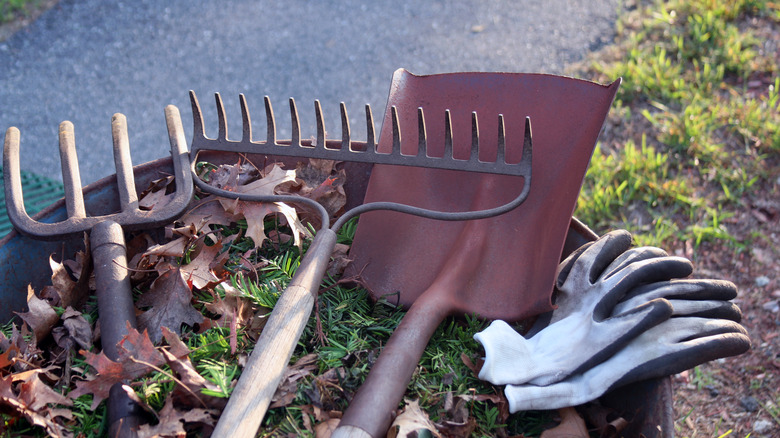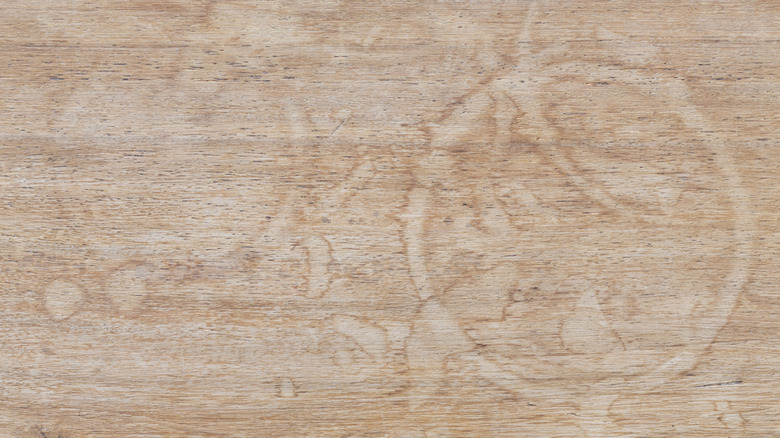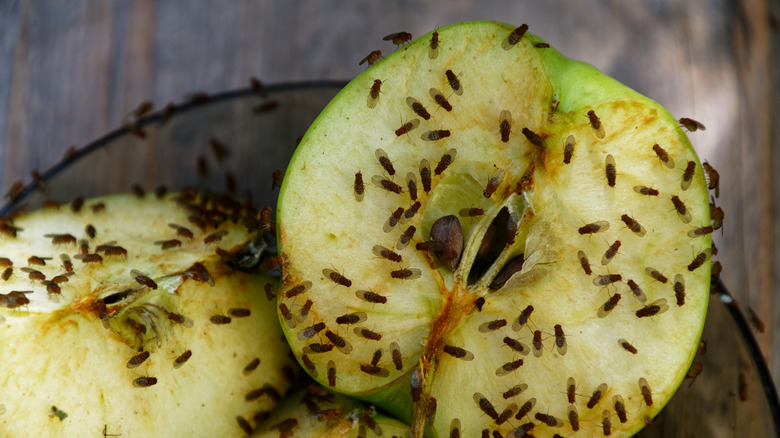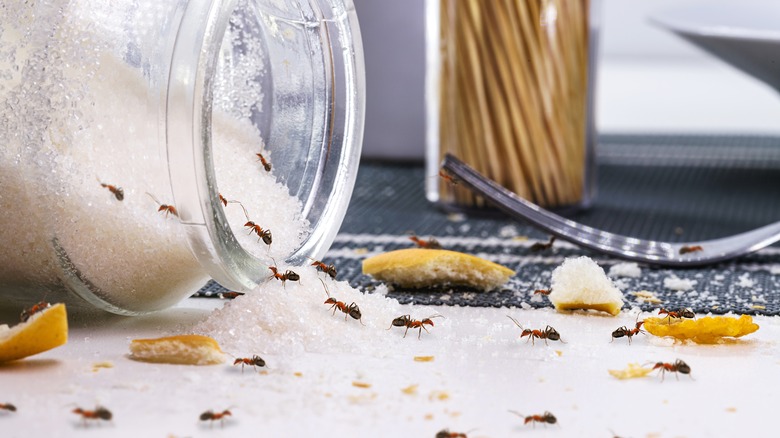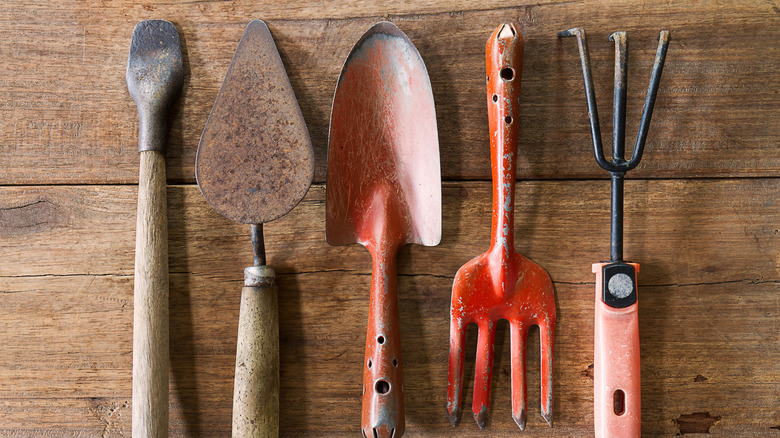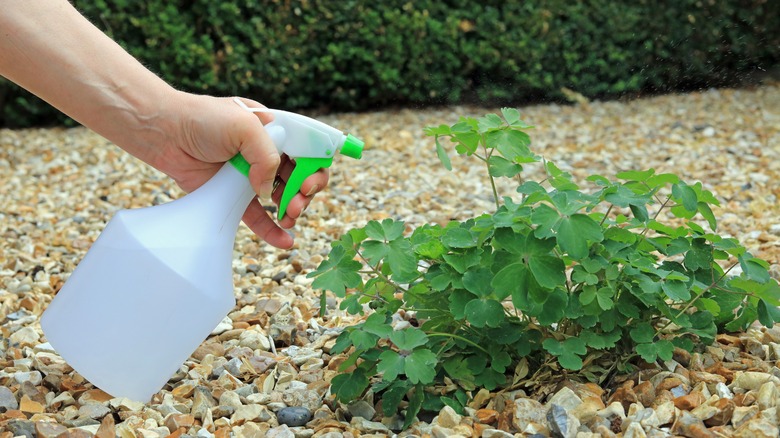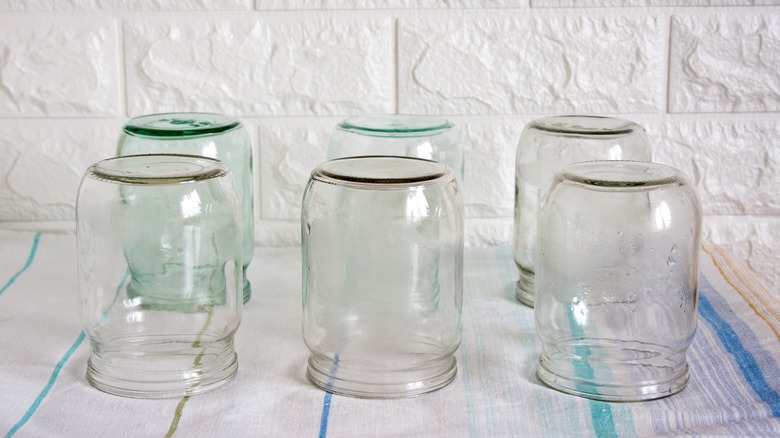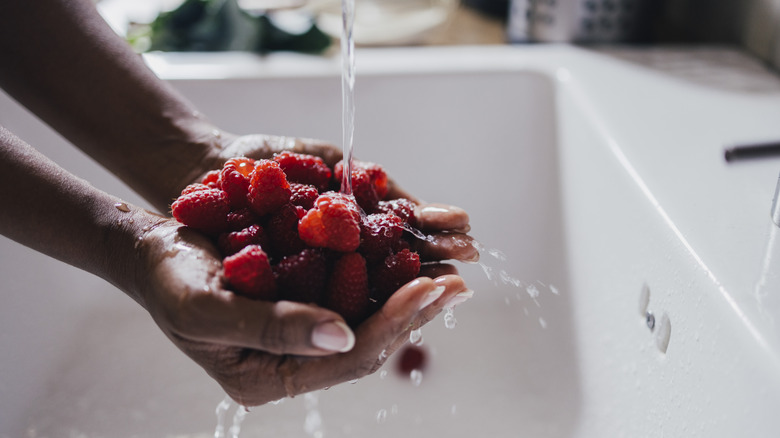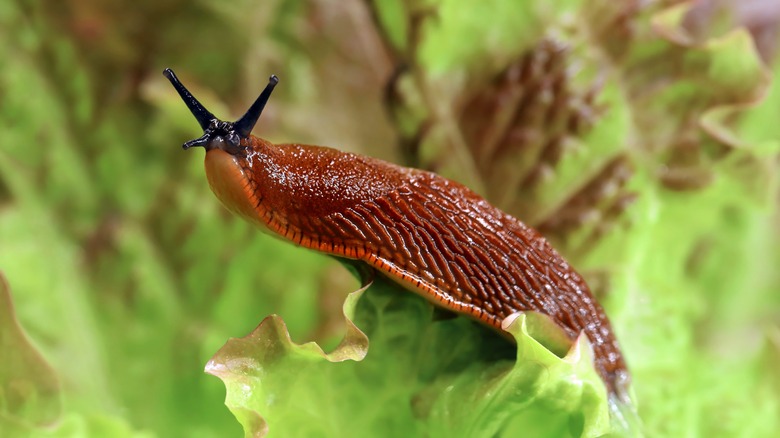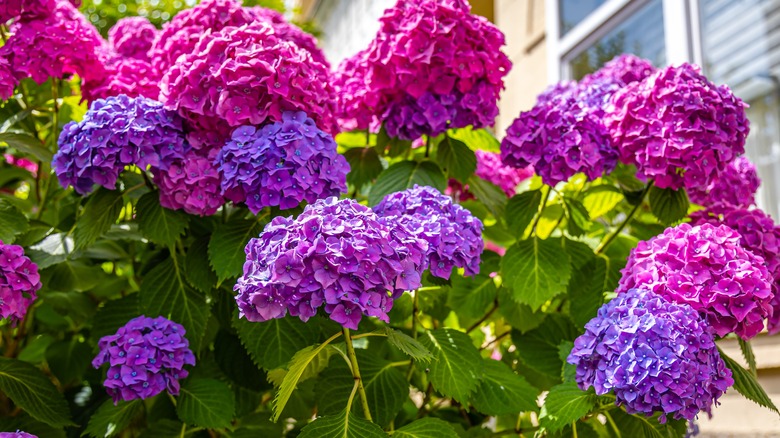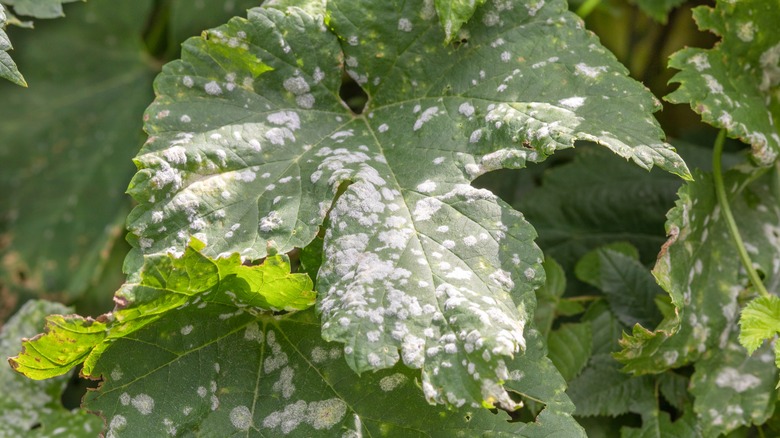How To Use Vinegar To Fix Issues Around The House
What do Caesar salads and soiled surfaces have in common? They both can benefit from a dash of vinegar. The same tangy properties that make vinegar a kitchen staple are what render it a great household ingredient to have on hand for tackling tasks around the home. Containing up to 6% acetic acid, vinegar has an ultra-low pH of between 2-3, which allows it to cut through grime and combat mold and bacteria.
Thanks to its acidic nature, vinegar is a popular, cheap, and effective natural cleaning ingredient, but its uses aren't just confined to shining glass and scrubbing toilets. There are many other jobs around the home that vinegar can help you handle, from eradicating water rings on furniture to banishing pests, boosting blooms, and more. For example, did you know vinegar can help in a pinch if your kitchen's covered in fruit flies or your garden tools are spotted with rust? If you love relying on natural, thrifty solutions over expensive niche products, vinegar deserves a place in both your pantry and your potting shed. Stick around to find out all the smart ways you could be using vinegar to fix issues around the home.
Removing water marks from furniture
Do you have a beautiful piece of wooden furniture that's marred by a pale-colored water ring? Vinegar could be the answer you've been searching for. As mentioned above, the active cleaning ingredient in vinegar is acetic acid, which is used in certain solvents. Watermarks that have a whiteish hue are caused by moisture that has damaged and permeated the finish. Vinegar can gently eat at the top layer of the sealant or varnish, allowing some of the trapped moisture to escape. This creates a similar effect to sanding the spot but without the elbow grease and dust. If you add oil to your vinegar solution, this will help to condition the wood and restore the area to its previous color.
All you have to do is combine white vinegar and some olive oil in a 1:1 ratio. Apply some of the mixture to a cloth and rub over the watermark, following the wood grain. Results aren't guaranteed, but people have had anecdotal success with this hack for diminishing light moisture marks. You can also try out the hairdryer water ring removal trick for pale marks, which entails blasting the ring with a constantly moving hair dryer set on the lowest setting. This will help the trapped moisture lift. If you're dealing with a severe stain that has a dark color, this means the moisture has most probably seeped all the way into the wood. In this situation, sanding down the surface is usually the best solution.
Eradicating fruit flies
Fruit flies absolutely love tart acids— to the point that they also go by the name of vinegar flies! These tiny pests tend to make their presence felt during the summer months. They sit on fruit, crawl into drinks, and rise as a cloud-like mass when disturbed in the kitchen. If you're plagued by these microscopic nuisances, it's time to take action. During the ripening process, fruit sugars get converted into acetic acid. Fruit flies feed on acetic acid, which explains their obsession with vinegar and makes it the perfect bait to use in a trap.
To create a fruit fly trap, take a jar and fill it partially with vinegar. Drop in a small squirt of dish soap and mix. The dish soap acts to break the surface tension of the vinegar, allowing the insects to fall into the liquid rather than just sitting on top of it. To prevent further escapees, you can also secure a piece of plastic kitchen wrap over the top of the jar with a rubber band and poke holes in it. This will allow the flies to climb in but will make it harder for them to fly out again.
Want to ramp up the tasty factor and potentially attract even more fruit flies? You can also add a couple of spoons of sugar to the mix. A study published by Columbia University shows that hungry flies are highly attracted to acetic acid, while full fruit flies will be drawn to sugar.
Deterring ants
Another tiny and equally annoying intruder is ants. They too tend to make a beeline for kitchens where they can score free food and get a drink at the sink. Targeting ants in the kitchen can be tricky because this is the last place you want to be spraying toxic ant repellants. The good news is that a safe solution might be sitting right behind your pantry door. A 2023 study published in "Animals" shows that acetic acid is an aversive substance for ants and can disrupt their traveling and social behavior. This explains why even professional pest control companies like Orkin recommend using vinegar as a DIY ant deterrent. Ants operate by sending out scouts to find sources of food. These forerunners leave pheromone trails for worker ants to follow. Pretty soon, these trails turn into highways teaming with ant activity, and no amount of soap or bleach can remove the scent roads. As soon as you stop cleaning, the ants will start traveling down them again. Vinegar is one of the few substances that can disrupt ant pheromone trails.
All you have to do is mix a solution of water and vinegar in a 1:1 ratio, fill up a spray bottle, and apply it to all the areas where you've seen ants. (Just be careful with natural stone finishes, as the acid can damage them.) Although vinegar can effectively deter ants and disrupt their trails, it won't kill them or eradicate their nests. For full extermination, you will probably need to call in a pest control service.
Breaking down rust
Cleaning up rusty metal is never a nice job, and it usually involves quite a lot of elbow grease. If you want to work smarter, not harder, let vinegar do some of the work. Vinegar can eat away at stubborn rust spots, lifting flakes right off, and revealing clean metal underneath. The science behind this is pretty simple. Vinegar contains acetic acid. When combined with rust, a chemical reaction occurs that binds the acetic acid and iron particles together and turns the rust into salt. You can then easily wipe away the salt. You can harness this reaction to help you clean anything from rusty garden tools to screws to jar lids to keys — you name it.
To get started, simply soak the rusty items in vinegar overnight. Then, remove them from the vinegar and scrub them in clean water. If you're de-rusting things like nails, tools, or other items where you'll be leaving the metal bare, give the surface a wipe with oil once it's fully dry. Just about any type of oil will do the trick, including cooking oil.
Vinegar's ability to make metal gleam again isn't limited to steel. You can also use it to break down stubborn layers of tarnish on old brass and copper items, but be sure to dilute it with water and not let the items soak too long. Because brass and copper are softer than steel, too much vinegar can dull their surfaces.
Conquering weeds
Vinegar is one of the most powerful DIY herbicide ingredients and has been scientifically proven to be effective against certain weed species. Cornell University conducted a project where they found that three applications of 5% acetic acid controlled over 90% of weed growth over a five-week period. The project compared the performance of the acetic acid in vinegar against commercial herbicides and glyphosate and found vinegar to be a viable weed killer. This is thanks to its low pH, which can kill leaves and stems on contact. The US Agricultural Research Service has also stated that vinegar is a potent and safe weed killer. However, keep in mind this is most effective on young weeds without established root systems. Old weeds with thick, long roots will have to be eradicated in a different way.
If you want to use this hack to zap weeds in your yard, all you have to do is fill a spray bottle with some white vinegar and add a few drops of dish soap. The dish soap isn't critical, but it does act as a surfactant, helping the vinegar to spread, mist, disperse, and stick to the plant leaves. Some people also like to add a cup of salt per gallon of vinegar, but this is only a good idea if you aren't spraying close to other plants, as too much salt isn't good for the soil. Speaking of other plants, keep in mind that vinegar doesn't discriminate. If you happen to spray it on non-weeds, it will kill their leaves too. Because of this, vinegar sprays tend to work best on gravel driveways, paved areas, and pathways.
Getting rid of glue residue
Reusing glass jars is a great way to cut down on waste, but there's one problem. That pesky glue residue. And leftover glue isn't just an issue on jars. Price tags can also leave behind annoying, sticky spots that attract dirt and fluff. Getting rid of glue residue is no easy task, but vinegar can help make the job a little easier. Acetic acid is corrosive, even at the low concentrations found in vinegar. A study published in the "Journal of Cultural Heritage" states that acetic acid is particularly effective at breaking down animal glues, aka gelatine-based adhesives.
If you want to tackle a tacky glue spot with vinegar, it's best to let the item soak so the acetic acid has time to soften the residue. If this isn't possible, like with electronic items, you can saturate a paper towel in vinegar and lay it over the spot. After letting the vinegar sit, scrape off the excess glue. Unlike strong solvents such as acetone, vinegar probably won't eat or dissolve the glue, but it should make it softer. You will need to give the item a final scrub with an abrasive cleaning pad and soap. For glue residue on clothes, soak the spot in vinegar, and then scrub the area with a toothbrush and some detergent.
Resurrecting old paintbrushes
If you've forgotten to wash out a paintbrush — and you're faced with a stiff bristled mess as a result — vinegar can be a handy remedy. While there aren't any studies that prove vinegar's effectiveness for softening paint, derivatives of acetic acid are a key ingredient in lacquer and paint solvents. Therefore, it makes sense that vinegar can help clean and soften stiff brush bristles.
To revive a hard paintbrush with vinegar, you'll need to start by heating it on the stove. Once the vinegar is hot, pour it into a heat-resistant jar. Make sure there is enough vinegar to cover the bristles and leave the brush to soak for half an hour or more. After soaking, wash it with warm water and dish soap. Use a scrubbing brush to get the loosened paint out of the bristles, and voilà, some of the softness should be restored. Are stiff brushes not the only problem left behind by your last paint project? You can also use heated vinegar to help remove water-based paint spots from concrete. Pour it over the area, allowing the vinegar to soak in, and then scrub the patch with soap and water. If you're thinking of painting raw floors, you can even use white vinegar as a concrete primer.
Clean your fruits
If you've discovered a punnet of berries covered in a blanket of grayish mold — after even just a few days in the fridge — you'll love this hack. Berries can develop mold very quickly thanks to their delicate skins and high water and sugar content. What's more, the berry industry is plagued by a species of mold called Botrytis fruit rot. Rhizopus and Fusarium are two other types of mold common to berries. Berries can carry mold spores on their skins. Positioned here, the spores are ready to take hold the moment the fruit reaches peak ripeness. The answer to this unappetizing problem? Vinegar. Acetic acid's scientifically established antifungal actions are one of the reasons why it's widely used as a food-preserving agent. A study published in the "American Society for Horticultural Science" showed that vinegar can stop Botrytis spores from germinating on strawberries and other fruits.
To leverage vinegar's mold-busting ability, soak your berries in a 3:1 ratio of water and white vinegar as soon as you bring them home. Leave them in the solution for about 10 minutes, remove them, and allow them to dry before storing the berries in the fridge.
Adding vinegar to vase of water to keep cut flowers fresh
One of the problems with buying flowers is their short lifespan. If you want to make your money and your floral arrangements go further, adding vinegar to their water can be a cheap and easy hack. It acts as a biocide, helping to control bacterial activity in the water and preventing the stems from rotting. A study conducted by the University of Massachusetts Amherst showed that sugar can effectively provide immature flower buds with the food they need to fully open. However, the researchers also stated that adding sugar can create a breeding ground for bacteria in the water, which can be counteracted by decreasing the pH. Vinegar's low pH makes it a perfect vase water additive.
If you want to make your cut flowers last like a pro florist, lace your vases with 2 tablespoons of sugar and 2 tablespoons vinegar per pint of water. This works out to roughly four tablespoons for a medium-sized vase. You can also substitute the sugar for a cup of flat soda or lemonade. But be aware that not all flowers benefit from sugar. Tulips and marguerite daisies don't like sweet water, and it also won't do much for daffodils. For these species, it's best to only add the vinegar.
Repelling snails and slugs
If your garden is flourishing, it's pretty much bound to attract slugs and snails. These squishy visitors can wreak quiet havoc, leaving new tender leaves looking like lace in just a night. Vinegar is one way you can make your garden less attractive to these slippery characters. A study published in the "Environmental Research Journal" revealed that wood vinegar can repel both slugs and snails. Wood vinegar is usually far stronger than regular white vinegar, but in this study, researchers found that the slugs and snails responded to acetic acid in solutions as weak as 10% and under.
So how do you use vinegar in the garden? If you're growing vegetables in planter boxes, you can spray the sides and rim with pure vinegar. Avoid spraying plants as the acid can destroy their cell membranes and damage them. You can also use it to spray the slugs and snails directly — the liquid will melt them, killing them on contact. If you see any slug trails, you should also wipe them away with vinegar. Mucus trails alert slugs and snails to each other's presence and may attract more individuals, as trails can signal that there's a food source or a mating opportunity present. Procreating slugs are the last thing you want in your garden, so bust out the vinegar!
Boost acid-loving blooms
Certain plants, like blueberries, camellias, hydrangeas, and azaleas, thrive best in acidic soils. If you have an acid-loving plant that's struggling, adding vinegar can be a quick fix. White vinegar has a low pH, and applying it to soil can increase acidity. According to a 2005 study published in the "Journal of General Plant Pathology," 1,900 milligrams of acetic acid per kilogram of soil can reduce pH to 5.7, which is considered acidic.
If you want to give acid-loving plants the pH drop they need, you should first test your soil to determine your starting point. To make sure you don't over-acidify the soil, start off slow by adding just a few tablespoons of vinegar to your watering can. Based on the above numbers, 3 tablespoons of vinegar should drop the pH of a small planter pot significantly, but it won't hurt its roots. After applying, test your soil's pH again and see if it has dropped. The acetic acid in vinegar does break down over time, so you will need to reapply every few seasons. For a longer-lasting treatment, it's more efficient and effective to utilize acidic matter on your soil (such as spreading pine needles or peat moss on the dirt in the fall,) but this hack has a lot of anecdotal success among gardeners and can work in a pinch.
Controlling powdery mildew
Powdery mildew is a highly persistent fungus that can plague plants like tomatoes, roses, cucurbits, and artichokes. Pure vinegar is not something you should be spraying on plants (unless they're weeds you want to kill), but applying a diluted solution could help you control this hard-to-beat disease. According to a paper published in "Crop Protection," solutions containing 5%-10% white vinegar yielded effective control over powdery mildew on rose plants.
The key to success is to address powdery mildew before it takes a strong hold. So if you're seeing telltale patches of white and gray, now is the time to act. To start, wipe down the affected leaves with a piece of damp paper towel or a wet rag. Then mix up a solution of vinegar and water. The stronger you make the solution, the more of the fungus it will kill, but too much acetic acid can also damage your plants. Play it safe by making a weak solution of 1-2 teaspoons of vinegar per gallon of water. If your plants seem to handle this fine, you can slowly up the strength. Powdery mildew is a really pernicious plant fungus, so a once-off treatment probably won't be enough to rid your plants of it. You'll likely need to spray regularly throughout the season, and even ongoing applications will probably only work to control it, not eradicate the problem completely.

